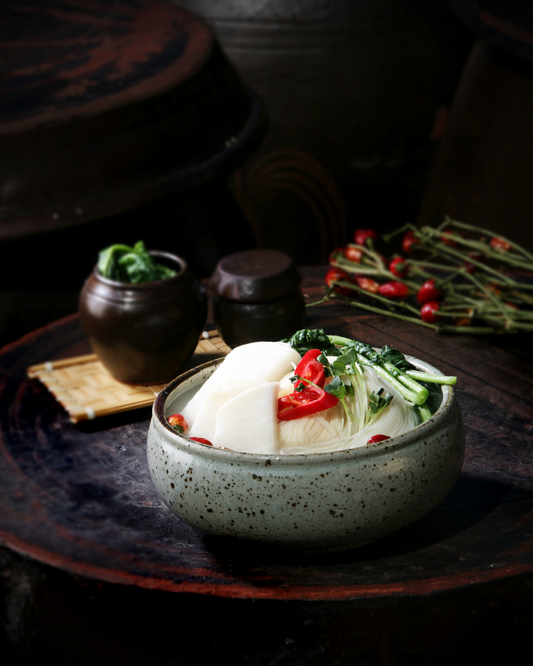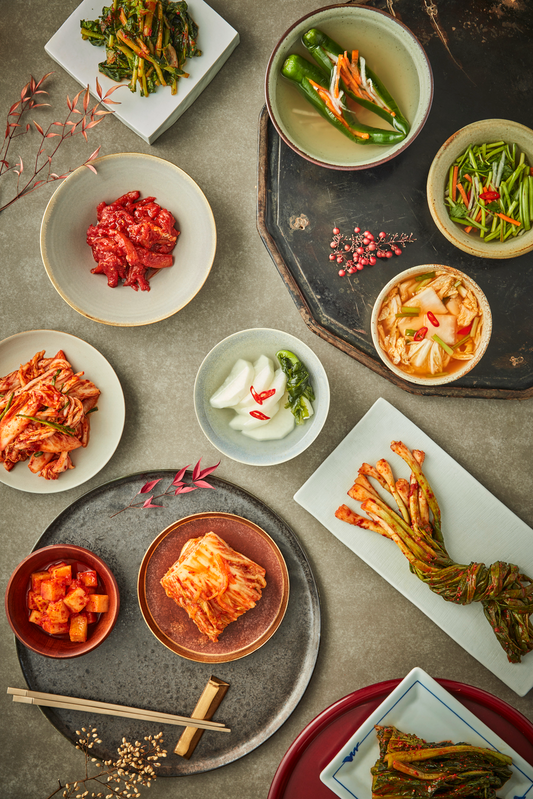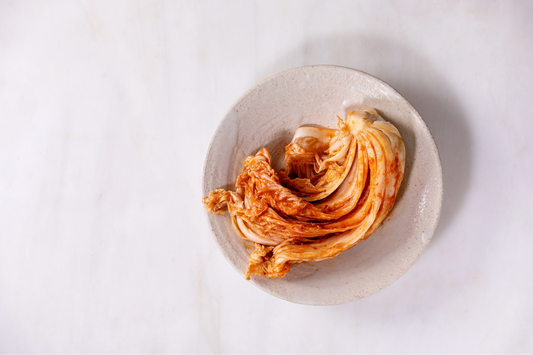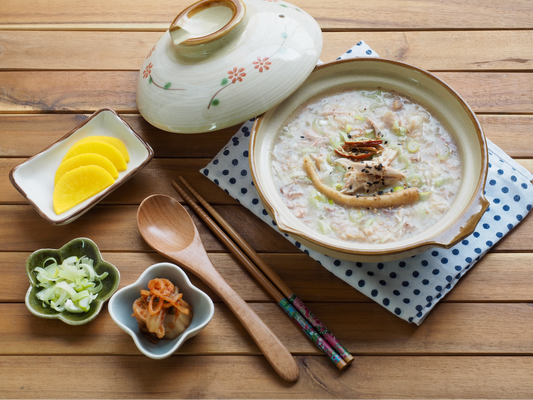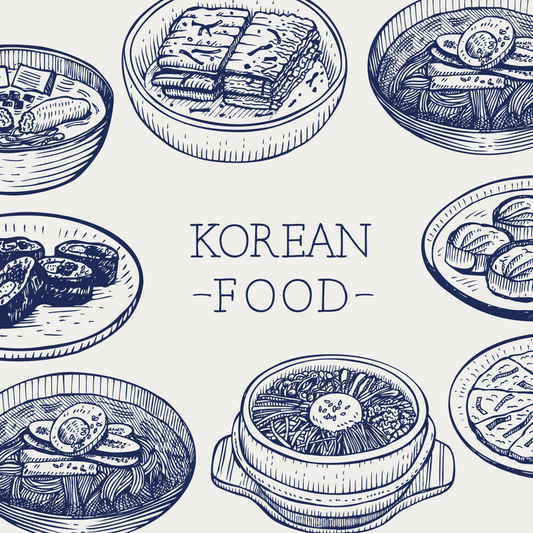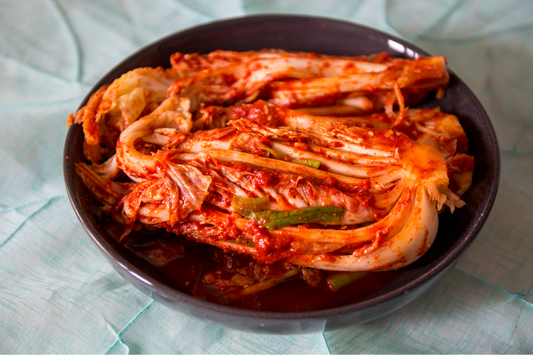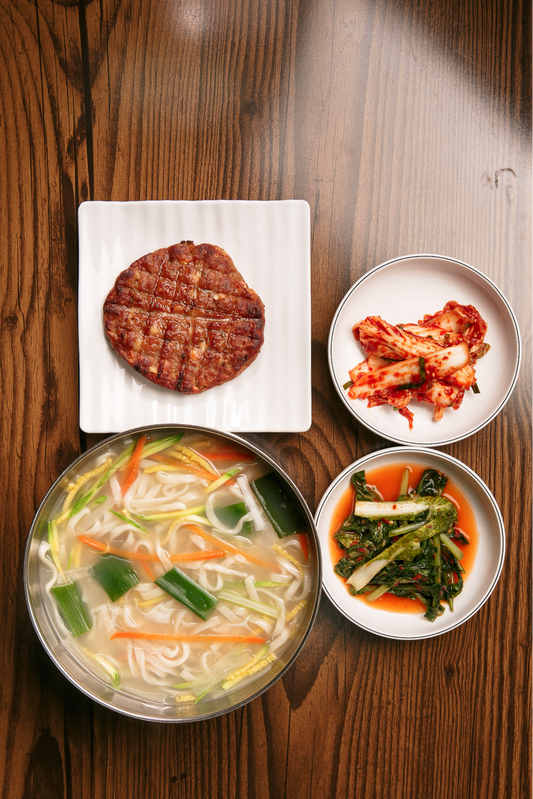Kimchi is a major part of Korean food, known for its health perks and complex taste. It blends the umami taste with sweet pears and sour apples, creating a rich flavor mix. This combination is sure to excite your taste buds.
Unpacking the Umami: Delving into Savory Layers
The umami taste in kimchi comes from fish sauce and fermented shrimp, adding a deep flavor. This taste, like meat or broth, is key to kimchi's unique taste. The umami balances out the spiciness and sourness, making the flavor just right.
Sweet Sensations: The Role of Pear and Apple
Sweet pears and apples in kimchi bring in more than sweetness. These fruits make the taste smooth and pair well with the strong veggies. Their sugars help with fermentation, boosting the probiotic benefits. This light sweetness also contrasts nicely with the saltiness, giving a layered taste.
Every part of kimchi adds to its celebrated flavor mix. From the rich umami taste to the natural sweet pears and apples in kimchi, all ingredients are crucial. They make the perfect kimchi, loved in Korean cuisine.
Kimchi's Probiotic Attributes and Gut Health Advantages
Exploring the kimchi probiotic benefits shows its big effect on gut health. This Korean dish does more than taste good. It's key for a healthy gut microbiome and full of nutrients. Thanks to its fermentation, kimchi has lots of health perks. It's like yogurt because it has lactic acid bacteria. This makes kimchi a good probiotic that helps digestion.
Studies back up the good things about kimchi. Regularly eating kimchi helps men manage their weight. It even lowers obesity by around 10%. This points out how kimchi fits well in a healthy diet. It keeps the gut microbiome balanced.
But, eating too much kimchi can be bad because of its high sodium level. It might have more than 20% of what you should have in a day per cup. Still, kimchi helps with heart health and losing weight. It's good for you if you eat it right. Plus, you can use it in many recipes. This makes it easy to enjoy its health benefits.
"Embracing kimchi in daily meals can significantly uplift one’s dietary regimen by infusing it with beneficial probiotics, crucial for a healthy gut microbiome."
The kimchi probiotic benefits go further than just helping digestion. They might also cut down inflammation and boost the immune system. This is because of certain strains like Lactobacillus. So, kimchi is not just tasty. It's a strong choice for stronger gut health and immunity.
Production Process: Crafting the Perfect Batch of QuickKimchi

The QuickKimchi production process starts by picking top-notch ingredients. It's vital to choose everything, from Napa cabbage to garlic, carefully to ensure they're fresh and pure. This step is key to making every batch of kimchi high-quality, with consistent taste and fermentation.
The journey of making fermented kimchi begins with thoroughly washing and carefully salting the cabbage. This process cleans the veggies and starts osmosis, releasing water. This creates the perfect setting for fermentation to happen. Being precise here lays the foundation for an exceptional kimchi batch.
Next, the right amounts of fish sauce, gochugaru, and spices are mixed to make the kimchi paste. This mix gives the kimchi its rich flavor and umami. When this paste coats the prepared vegetables, the maker's skill makes sure each leaf gets an even layer. This ensures the flavor and fermentation are the same throughout.
It's crucial to ferment the mix in just the right conditions, away from the sun and at a steady temperature. Whether it ferments for days or matures in the fridge, every part of the QuickKimchi production process influences the final product's quality and taste.
The sealed containers also play an essential part; they keep out contaminants and maintain an anaerobic environment for fermentation. Here, the kimchi becomes more complex, turning into a savory, tangy treat many love. Careful attention to these steps is critical to producing a top-notch kimchi batch, showing QuickKimchi's dedication and craftsmanship.
The average person eats a lot of this staple. The making of it, rooted in tradition yet fast and efficient, shows the blend of art and science in creating a treasured food item.
Sourcing Local: The Impact on QuickKimchi’s Flavor Profile
The freshest ingredients bring out the best in QuickKimchi's flavor. Sourcing local ingredients boosts the taste, quality, and sustainability. The unique flavor is largely due to local produce.
Using Napa cabbage, radish, and scallions from local farms makes a big difference. It cuts down the time between picking and fermenting. This keeps the vegetables crisp and flavorful, making QuickKimchi especially tasty and fresh. Also, buying local helps farmers and cuts down on pollution by reducing the need to transport goods far.
The local produce used in kimchi makes it taste more authentic and changes slightly with the seasons. These changes give every QuickKimchi batch its own special flavor. This makes eating it a unique experience each time.
So, using local ingredients not only makes QuickKimchi taste better, but it's also good for the planet and local communities. It's a win-win in the world of food today.
"Kimchi" - The All-Star Ingredient in Korean Cuisine
Kimchi is more than a dish; it's a cultural symbol of Korean cooking. This Korean cuisine staple is famous worldwide, found in both Seoul family dinners and New York's trendy eateries. Kimchi brings a unique taste to every table it graces.
Kimchi can take many forms. From napa cabbage based baechu-kimchi to the crisp oi-sobagi (cucumber kimchi), it does more than just accompany meals. It enhances them. This versatile condiment is key in both traditional dishes like bulgogi and in modern cuisines looking for a zesty twist.
The making of kimchi is an art handed down through generations. It starts with careful salting and washing of the cabbage. Then, a rich paste of garlic, red pepper flakes, and spices is added. Each step is done with care to achieve kimchi's iconic spicy, savory, and umami tastes.
"A bite of kimchi is to taste the soul of Korea."
Kimchi isn't just tasty; it's also good for health. Its fermentation brings out many probiotics, boosting digestive health. Kimchi comes in varieties from sweet to very spicy. It can be a side dish with ramyeon or Korean BBQ. Kimchi's flavors are diverse but always essential.
Kimchi's widespread love and its importance in Korean meals highlight its key role in Korean cuisine. It's no surprise it's seen as a Korean cuisine staple. Kimchi delights food lovers in Korea and worldwide, making meals unforgettable.
Sustainability in Kimchi Production: A Responsible Choice
Making kimchi with a focus on sustainability is key. It's more than making tasty food. It involves caring for our planet at each step of production. From farming to keeping, it ensures the Earth suffers less. It uses ways that are good for our environment.
Environmental Considerations in Kimchi Ingredient Farming
Sustainable kimchi production cares deeply about the environment. This is true in growing Napa cabbage, radishes, and scallions. By avoiding harsh chemicals, the soil stays healthy and full of life. Choosing local and seasonal stuff cuts down on emissions from transport. It also helps nearby farmers. Making sure farms are clean keeps our water and soil safe. It shows caring for our planet in every step.
Green Techniques in Preserving Kimchi Ingredients
Kimchi's keeping phase gains a lot from green preservation techniques. Fermentation is a cool, natural way to make food last longer. It uses little energy and avoids fake preservatives. This means less energy used, which is good for the planet. Fermentation also means we waste less food. Kimchi's perfect pH makes it safe and tasty. It's a food that loves our culture and planet alike.
Embracing the Depths of QuickKimchi Ingredients
Understanding QuickKimchi means diving into its rich flavors. Ingredients like grape tomatoes, napa cabbage, and daikon radish blend together. They create a delicious mix of tastes and textures. This turns simple veggies into a fermented delight in just two and a half hours, showcasing the power of kimchi's ingredients.
The Grape Tomato ‘Quick Kimchi’ is a treat blending Korean and American tastes. It can be made in 35 minutes with a special Banchan dressing. This uses both traditional and local ingredients for a tasty summer starter. Kimchi Mandu combines tofu, noodles, meats, and more. It shows the rich layers of QuickKimchi in just 1 hour and 15 minutes, feeding up to 12 people.
Fermentation brings out more than just flavor in food. It boosts health, aiding digestion, immune function, and adding probiotics. QuickKimchi is key in Korean dishes for its health benefits. The real skill in QuickKimchi cooking is tweaking it—like using kiwi instead of Korean pear. This doesn't hurt its nutritional value. QuickKimchi is more than food; it's a blend of culture, health, and creativity.
FAQ
What are the main ingredients in QuickKimchi and what health benefits do they offer?
QuickKimchi includes napa cabbage, garlic, ginger, red pepper powder, and fruits and vegetables. These ingredients give you vitamins, minerals, dietary fiber, and probiotics. They help with digestive health, boost your immune system, and improve your overall health.
Why has QuickKimchi become so popular in Western countries?
QuickKimchi is loved in the West because it's versatile, tasty, and healthy. It's also easy to prepare unlike traditional kimchi. People like it for its probiotic benefits too.
How does napa cabbage contribute to the flavor and texture of QuickKimchi?
Napa cabbage makes kimchi crunchy and a bit sweet. It blends well with spices, creating QuickKimchi's unique taste.
What role do garlic and ginger play in the flavor of QuickKimchi?
Garlic and ginger bring a spicy and strong flavor to QuickKimchi. They add savory notes to the dish.
Why is red pepper powder used in QuickKimchi, and what does it add to the dish?
Red pepper powder adds heat, color, and depth to QuickKimchi. It’s a key ingredient that makes the dish spicy and appealing.
Can you explain the nutritional aspects of QuickKimchi ingredients?
QuickKimchi is low in calories but high in essential nutrients. Napa cabbage, garlic, and ginger are packed with vitamins A, B, C, K, and minerals like calcium and iron. They're great for your gut health too.
What is the importance of the cultivation and harvest process in the production of QuickKimchi?
The quality of QuickKimchi starts with how the ingredients are grown and harvested. Good farming gives better tasting and more nutritious ingredients. The soil and farming methods also play a big role.
How does fermented kimchi like QuickKimchi benefit our health?
Fermented kimchi boosts your gut health with its natural probiotics. These good bacteria help with digestion and can improve your immune and mental health. Plus, it's full of vitamins and minerals.
What innovative preparations are introduced in making QuickKimchi?
QuickKimchi can include new veggies, fruits, or different sweeteners like coconut sugar. There are also vegan options available. This keeps the traditional flavor while adding something new.
How does the taste spectrum of QuickKimchi balance the savory and sweet aspects?
Savory flavors in QuickKimchi come from things like anchovy fish sauce and garlic. Sweetness from fruits like pears and apples balances out the spice. This mix creates a full and pleasing flavor.
What are the probiotic attributes of kimchi and how do they support gut health?
Kimchi's probiotics balance your gut, help digestion, and reduce stomach issues. Eating kimchi adds these good bacteria to your diet, helping your digestive system.
What does the QuickKimchi production process entail?
Making QuickKimchi involves precise ingredient mixing, keeping things clean, and controlling fermentation. This ensures it tastes good and is healthy for you.
How does sourcing local ingredients affect QuickKimchi's flavor profile?
Using local ingredients makes QuickKimchi taste fresher and more authentic. It supports local farmers and lessens the environmental impact of making kimchi.
Why is kimchi considered a staple in Korean cuisine?
Kimchi is key in Korean food because of its unique flavor. It goes well with many dishes, making it an important part of Korean meals.
What sustainable practices are integrated into kimchi production?
Sustainable kimchi making includes using organic farming, reducing pesticides, energy-saving storage, and green packaging. This helps protect our planet while making this traditional dish.
What are the depths of QuickKimchi ingredients?
QuickKimchi ingredients have rich flavors, textures, and health benefits. Appreciating QuickKimchi means seeing the value in natural ingredients, culinary traditions, and new twists.









